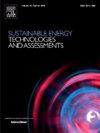Integrated energy, exergy, and environment (3E) analysis, and life cycle assessment of renewable sourced multigeneration system for optimized performance and environmental impact assessment
IF 7.1
2区 工程技术
Q1 ENERGY & FUELS
Sustainable Energy Technologies and Assessments
Pub Date : 2025-06-02
DOI:10.1016/j.seta.2025.104368
引用次数: 0
Abstract
Energy has become a vital entity in this modern era of industrialization. Despite being produced at larger scales there is a danger of crisis due to depleting fossil fuels and rising population ultimately resulting in higher energy demands. To cater for this issue, sustainable measures have become inevitable these days. In addition to the upcoming scarcity, another big issue threatening the current and upcoming generations is the environmental degradation due to carbon footprints and greenhouse gas emissions which are gradually affecting ozone levels thus posing serious threats to natural habitats and biodiversity. Sustainable energy solutions such as renewable energy sources can prove to be vital in mitigating resource depletion and environmental degradation impacts. Multigeneration systems can prove to be cutting-edge technology to produce sustainable energy and help achieve a green future. This research presents a novel clean energy based multigeneration system for sustainable energy and clean hydrogen production. Along with these, the system also produces cooling power, heating capacity, fresh and hot water as useful by-products. Thermodynamic and life cycle assessments have been conducted. The system is capable of producing 34.912 MW electric power, 0.04201 kg/s clean hydrogen, and reasonable amounts of other by products. The system showed 32.98 %, 85.11 %, and 63.66 %, of thermal, energy, and exergy efficiencies, respectively. Life cycle assessment highlighted various potential hotspots of the system associated with carbon emissions.
综合能源、能源和环境(3E)分析和生命周期评估可再生能源多发电系统的优化性能和环境影响评估
能源已成为现代工业化时代的重要实体。尽管生产规模更大,但由于化石燃料的消耗和人口的增加,最终导致能源需求的增加,存在危机的危险。为了解决这个问题,可持续发展的措施已成为不可避免的。除了即将到来的稀缺,另一个威胁到这一代和未来几代人的大问题是由于碳足迹和温室气体排放导致的环境退化,它们正在逐渐影响臭氧水平,从而对自然栖息地和生物多样性构成严重威胁。可再生能源等可持续能源解决办法可证明对减轻资源枯竭和环境退化影响至关重要。多发电系统可以被证明是生产可持续能源和帮助实现绿色未来的尖端技术。本研究提出了一种新型的基于清洁能源的可持续能源和清洁制氢多联产系统。除此之外,该系统还产生制冷能力、制热能力、淡水和热水作为有用的副产品。进行了热力学和生命周期评估。该系统能够产生34.912兆瓦的电力,0.04201千克/秒的清洁氢气和合理数量的其他副产品。该系统的热效率、能量效率和火用效率分别为32.98%、85.11%和63.66%。生命周期评估突出了与碳排放相关的系统的各种潜在热点。
本文章由计算机程序翻译,如有差异,请以英文原文为准。
求助全文
约1分钟内获得全文
求助全文
来源期刊

Sustainable Energy Technologies and Assessments
Energy-Renewable Energy, Sustainability and the Environment
CiteScore
12.70
自引率
12.50%
发文量
1091
期刊介绍:
Encouraging a transition to a sustainable energy future is imperative for our world. Technologies that enable this shift in various sectors like transportation, heating, and power systems are of utmost importance. Sustainable Energy Technologies and Assessments welcomes papers focusing on a range of aspects and levels of technological advancements in energy generation and utilization. The aim is to reduce the negative environmental impact associated with energy production and consumption, spanning from laboratory experiments to real-world applications in the commercial sector.
 求助内容:
求助内容: 应助结果提醒方式:
应助结果提醒方式:


